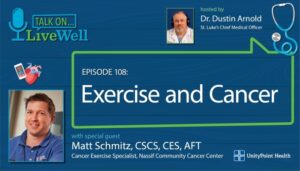Last week we discussed how maintaining a healthy diet and body weight and staying active can help to reduce your risk of developing certain types of common cancers. This week we will dive deeper into the topic of exercise and its benefit to patients, survivors, caregivers and anyone looking to lower their risk.
“Exercise can be an extremely empowering action,” says Matt Schmitz, cancer exercise specialist and integrative wellness program manager at the Helen G. Nassif Community Cancer Center. “It is well-known through numerous studies that exercise helps build strength, stamina and range of motion, but there is less publicity around how it can help prevent cancer and how it can help patients mentally during treatment.”
There are three components of exercise. Aerobic, which strengthens the heart and cardiovascular system. Strength, which builds muscular strength and in turn keeps joints more stable and increases bone density. And finally, flexibility, which reduces stiffness and improves range of motion. It’s recommended adults get at least two and a half hours of moderate aerobic exercise a week and do some type of strength-based exercise twice a week.
“Maintaining a healthy weight through nutrition and exercise is key,” says Schmitz. “Exercise and nutrition can also help decrease inflammation. Much like added weight, inflammation is another factor that can increase cancer risk.”
These physical benefits are accompanied by many mental benefits as well including decreased anxiety and stress, improved self-esteem, lower depression rates and better relaxation and sleep.
Now that you know the benefits, you may be asking “how do I get started?” Schmitz is available to meet with any cancer patient, survivor or caregiver to discuss their goals and develop a plan.
“When I first meet with a patient I like to discuss what they like to do, don’t like to do, hobbies, what they do for work and any previous injuries,” says Schmitz. “Their goals and exercise program should be based off a combination of these factors.”
When starting a new program Schmitz says that goals should be attainable and based in the present. “Many times people base goals on what they used to be able to do, they forget all the training that went in to being able to run that 5k three years ago for example.”
“I also feel that a goal can be based on allowing you to enjoy the end result,” says Schmitz. “For example, a new grandmother may not enjoy doing squats or chair sits, but as she builds up strength she will be able to get up and down off the floor to play with her new grandchild, so the end result is well worth it.”
Matt uses all of these factors to help build an exercise program that is customized to you, and will help you achieve your fitness goals and bring many other health benefits along with it. To learn more about the wellness program at the Community Cancer Center, click here.







